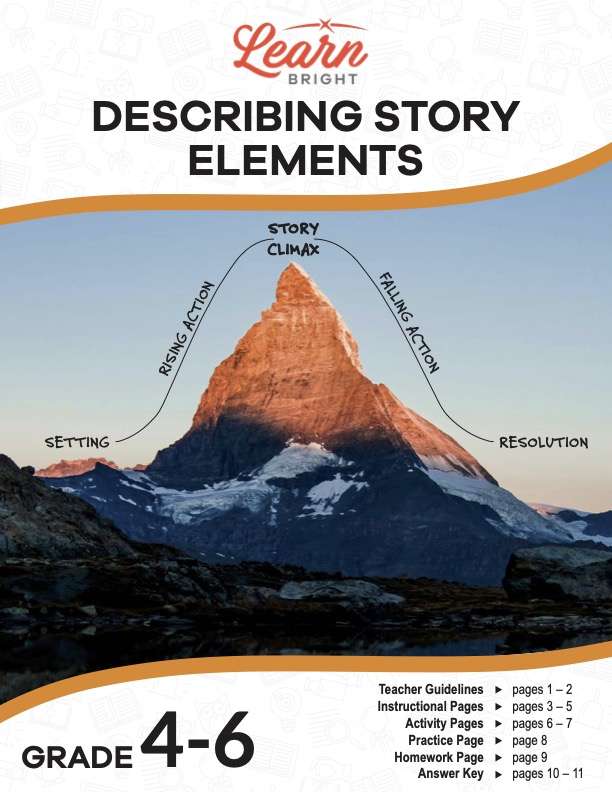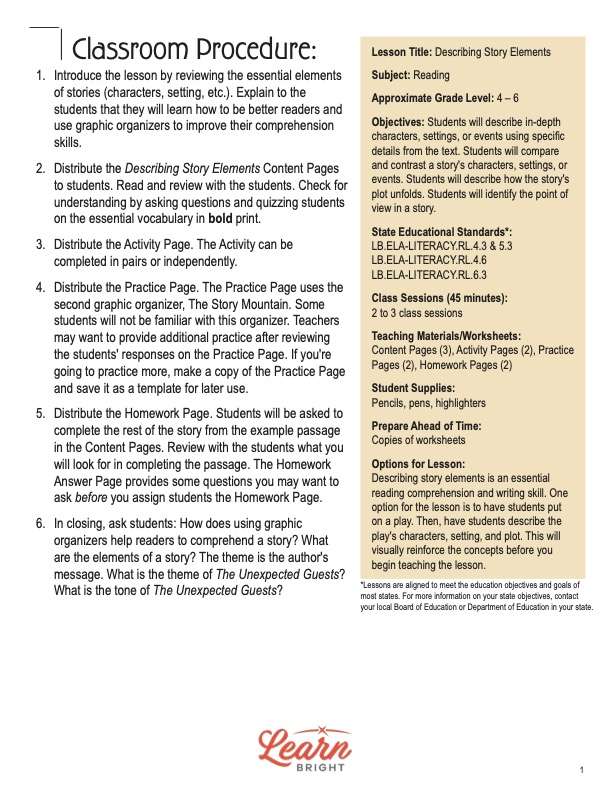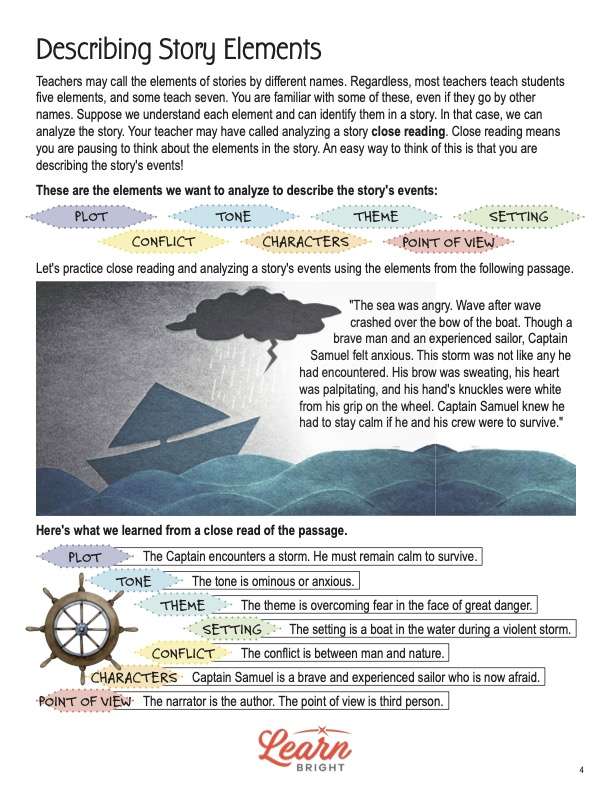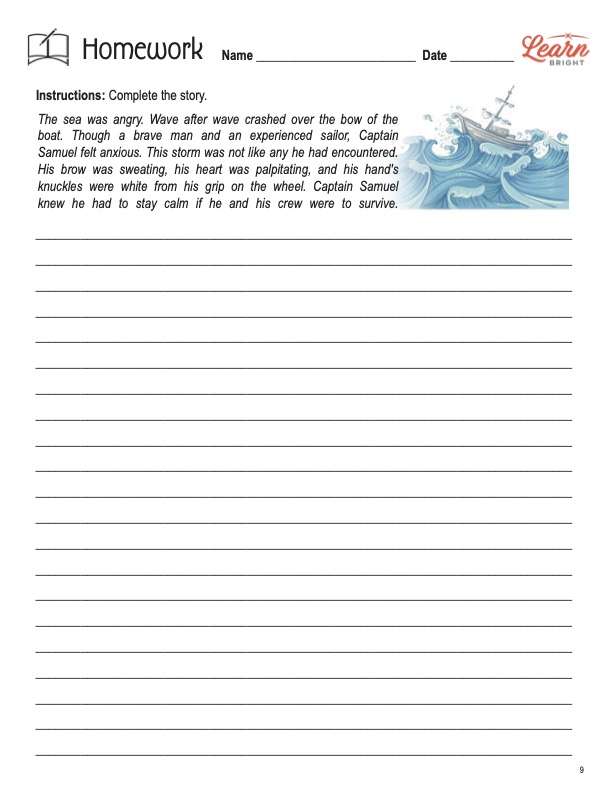Description
What our Describing Story Elements lesson plan includes
Lesson Objectives and Overview: Describing Story Elements helps students improve their reading comprehension in a fun way. Students will describe in-depth characters, settings, or events using specific details from the text. They will compare and contrast a story’s characters, settings, or events and describe how the story’s plot unfolds. They will also learn how to identify the point of view in a story. This lesson is for students in 4th grade, 5th grade, and 6th grade.
Classroom Procedure
Every lesson plan provides you with a classroom procedure page that outlines a step-by-step guide to follow. You do not have to follow the guide exactly. The guide helps you organize the lesson and details when to hand out worksheets. It also lists information in the yellow box that you might find useful. You will find the lesson objectives, state standards, and number of class sessions the lesson should take to complete in this area. In addition, it describes the supplies you will need as well as what and how you need to prepare beforehand.
Options for Lesson
You can check out the “Options for Lesson” section of the classroom procedure page for additional suggestions for ideas and activities to incorporate into the lesson. Describing story elements is an essential reading comprehension and writing skill. One option for the lesson is to have students put on a play. Then, have students describe the play’s characters, setting, and plot. This will visually reinforce the concepts before you begin teaching the lesson.
Teacher Notes
The paragraph on this page provides a little more information or guidance on what to expect from the lesson. It emphasizes that understanding a problem and solution will provide students with a gateway to comprehending the conflict, the motivations of characters, and the importance of the setting. You can use the blank lines to record any thoughts or ideas you have as you prepare.
DESCRIBING STORY ELEMENTS LESSON PLAN CONTENT PAGES
Story Elements
The Describing Story Elements lesson plan contains three pages of content. It begins with a review of the basics of reading. Reading fluency is the conversational rate at which you read with expression and accuracy. Record yourself reading aloud, and you will hear the expression in your voice. You will notice words or phrases that you read through quickly and others that are challenging. That leads to reading comprehension.
Reading comprehension is the ability to read and process a text or a story. It relates to how well you understand the story’s meaning and the author’s purpose. Fluency and comprehension can be improved through practice and reading strategies that are easy to learn. You are probably already doing some of them and don’t realize it. This lesson is all about strategically improving your comprehension!
At some point when you were first learning to read, you were taught that all stories have characters, settings, and actions. As you got older and improved as a reader, you were taught that in addition to those elements, there are point of view and plot. Point of view refers to who is narrating the story. Plot is what happens in a story. It is the sequence of events. Stories also have tone and a theme. The tone is the overall feeling you get from reading the story. The theme is the author’s message.
Students have learned that characters have traits. Traits are the physical or emotional descriptions of the characters. For example, consider the sentence, “Samantha was small in stature but big in heart—the kindest person I ever met.” In this sentence, we learn that Samantha is physically tiny and emotionally caring. Every story has characters that act and do things in certain situations. Sometimes, we call these motivations. Now, you might say to yourself, “Okay, I get it. But how do all of these parts or elements of stories help me become a better reader?” Great question!
Graphic Organizers
Teachers may call the elements of stories by different names. Regardless, most teachers teach students five elements, and some teach seven. You are familiar with some of these, even if they go by other names. Suppose we understand each element and can identify them in a story. In that case, we can analyze the story. Your teacher may have called analyzing a story close reading. Close reading means you are pausing to think about the elements in the story. An easy way to think of this is that you are describing the story’s events!
The lesson lists seven story elements that students will analyze: plot, tone, theme, setting, conflict, characters, and point of view. To practice, students will read a short paragraph about a ship captain stuck in a storm. After they finish reading, they will analyze the story based on each of those seven elements.
There are several ways to analyze a story. One way is to use a graphic organizer. The lesson provides a table that displays information from the story in a describing events organizer. Then it provides another type of organizer called a story mountain. It is called a story mountain because it graphs the action and plot of a story.
In our passage about Captain Samuel, the beginning event is a storm. The storm worsens, and Captain Samuel fears for his survival. We don’t have the climax yet, so we can only use parts one, two, and three of the story mountain. By closely reading and describing story events, we can dig deeper into a story and increase our understanding. Graphic organizers help us visualize the story and aid in comprehension.
DESCRIBING STORY ELEMENTS LESSON PLAN WORKSHEETS
The Describing Story Elements lesson plan includes three worksheets: an activity worksheet, a practice worksheet, and a homework assignment. Each one will help students solidify their grasp of the material they learned throughout the lesson. You can refer to the classroom procedure guidelines to know when to hand out each worksheet.
DESCRIBING STORY ELEMENTS ACTIVITY WORKSHEET
Students will read a story called The Unexpected Guests. They will then fill in the graphic organizer on the bottom of the second activity page. This organizer emphasizes the seven story elements that students learned about during the lesson.
STORY MOUNTAIN PRACTICE WORKSHEET
The practice worksheet is a continuation from the activity. Students will use the story mountain graphic organizer to graph out The Unexpected Guests. This organizer focuses mainly on the events of the story from beginning to end.
COMPLETE THE STORY HOMEWORK ASSIGNMENT
For the homework assignment, students will complete the story about Captain Samuel from the content pages. The initial paragraph is provided at the top of the page. Students can use the lines on this page as well as additional pages if necessary to finish the story.
Worksheet Answer Keys
There are answer keys at the end of the lesson plan document for the practice and homework worksheets. Students answers will vary given the nature of the assignments. For the homework, the answer key provides a list of questions that address the seven story elements from the content pages. If you choose to administer the lesson pages to your students via PDF, you will need to save a new file that omits these pages. Otherwise, you can simply print out the applicable pages and keep these as reference for yourself when grading assignments.









